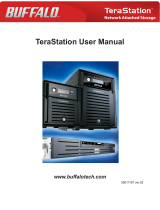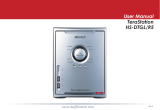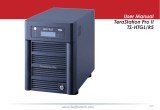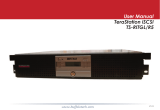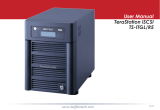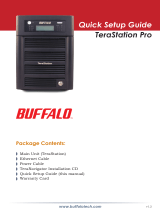Page is loading ...

Network Attached Storage
TeraStation 3010, 3020
User Manual
Please make sure to read this manual before using and follow the procedures. If you have any inquiries about
the product, contact the number on the warranty statement or the packing box. Do not discard the included
documents, the warranty statement, or the packing box.
Americas: www.buffaloamericas.com
Europe: www.buffalo-technology.com
Asia Pacific: www.buffalo-asia.com
35021138-24
June 2020

Notice
Regulatory Compliance Information
For Customers in the United States
This device complies with Part 15 of the FCC Rules. Operation is subject to the following two conditions: (1) this
device may not cause harmful interference, and (2) this device must accept any interference received, including
interference that may cause undesired operation.
Note: This equipment has been tested and found to comply with the limits for a Class A digital device, pursuant to
part 15 of the FCC Rules. These limits are designed to provide reasonable protection against harmful interference
when the equipment is operated in a commercial environment. This equipment generates, uses, and can radiate
radio frequency energy and, if not installed and used in accordance with the instruction manual, may cause harmful
interference to radio communications. Operation of this equipment in a residential area is likely to cause harmful
interference in which case the user will be required to correct the interference at his own expense.
For Customers in Europe
Warning: This is a class A product. In a domestic environment this product may be cause radio interference in which
case the user may be required to take adequate measures.
This product may cause interference if used in residential areas. Such use must be avoided unless the user takes
special measures to reduce electromagnetic emissions to prevent interference to the reception of radio and
television broadcasts.
Environmental Information
• The equipment that you have purchased has required the extraction and use of natural resources for its
production.
• The equipment may contain hazardous substances that could impact health and the environment.
• In order to prevent the dissemination of those substances into the environment, and to relieve pressure on
natural resources, we encourage you to seek out an appropriate take-back program. Take-back programs will
reuse or recycle materials of any end-of-life equipment in a responsible way.
• Products with the crossed-out wheeled-bin symbol above should not be recycled. Instead, seek out a take-back
program as mentioned.
• If you need more information on the collection, reuse, and recycling of our end-of-life products, please contact
your local or regional waste administration.
1
Notice

2
Notice
For Customers in Taiwan
BSMI
警告使用者 :
此為甲類資訊技術設備,於居住環境中使用時,可能會造成射頻擾動,在此種情況下,使用者會被要求採取某
些適當的對策。
Warning Symbols and Graphical Icons on the Product
Warning symbols are used on the product for safety operation and prevention of injury to you and damage to the
unit. The following explains the meanings of symbols used on the product.
This symbol indicates important warnings or cautions for operation and maintenance.
Additional information will follow this symbol.
This symbol indicates the presence of an alternating current.
This symbol indicates that the rack-mounted equipment should not be used for a shelf or a work
space.
This symbol indicates danger of hazardous high voltage.
Safety Precautions
Before using your device, basic safety instructions should always be followed.
(1) Read these instructions.
(2) Keep these instructions.
(3) Heed all warnings and follow all instructions.
(4) The socket-outlet shall be installed near the equipment and shall be easily accessible.
(5) Only use the cables and accessories that are included in the package. Don’t use other accessories or cables
unless specifically instructed to in the documentation. Also, do not use USB cables that are 3 meters or longer to
connect USB devices.
(6) The device can only be used in a fixed location, such as a telecommunication center or a dedicated computer
room. When you install the device, ensure that the protective earthing connection of the socket-outlet is verified
by a technician.
Translation to Norwegian:
Utstyr som er koplet til beskyttelsesjord via nettplugg og/eller via annet jordtilkoplet utstyr – og er tilkoplet et
kabel-TV nett, kan forårsake brannfare. For å unngå dette skal det ved tilkopling av utstyret til kabel-TV nettet
installeres en galvanisk isolator mellom utstyret og kabel- TV nettet.
Translation to Swedish:
Utrustning som är kopplad till skyddsjord via jordat vägguttag och/eller via annan utrustning och samtidigt
är kopplad till kabel-TV nät kan i vissa fall medföra risk för brand. För att undvika detta skall vid anslutning av
utrustningen till kabel-TV nät galvanisk isolator finnas mellan utrusningen och kabel-TV nätet.

3
Table Of Contents
Notice ..............................................................................1
Regulatory Compliance Information ..............................................1
Warning Symbols and Graphical Icons on the Product .................2
Safety Precautions ...........................................................................2
Chapter 1 Getting Started .......................................... 11
Diagrams ........................................................................................ 11
TS3010 Series TeraStations .....................................................................11
TS3020 Series TeraStations .....................................................................14
Turning the TeraStation On and Off............................................. 16
Re-Inserting Drives ....................................................................... 19
Creating a USB Initialization Drive .............................................. 19
Chapter 2 Configuration ............................................. 20
Configuring Settings via Setup Wizard ....................................... 20
Opening Setup Wizard ............................................................................20
Opening Settings .......................................................................... 21
Checking the Device Information from Dashboard ................... 23
Chapter 3 File Sharing ................................................. 24
Configuring Shared Folders ......................................................... 24
Adding a Shared Folder ...........................................................................24
Recycle Bin ................................................................................................26
Read-Only Shares .....................................................................................26

4
Hidden Shares ..........................................................................................27
Configuring Users ......................................................................... 27
Adding a User ........................................................................................... 27
Importing User Information ....................................................................30
Adding a Group ............................................................................. 30
Configuring Access Restrictions for Shared Folders .................. 33
Local Users and Groups ...........................................................................33
Active Directory .......................................................................................35
Configuring Access Restrictions for Subfolders ......................... 38
Enabling Subfolders’ Access Restrictions ..............................................38
Restoring Owner and Permission Settings ............................................40
If a Shared Folder Cannot Be Accessed........................................ 42
Chapter 4 Storage Management ................................ 44
RAID Modes ................................................................................... 44
Working with RAID Arrays ............................................................ 45
Using JBOD ...............................................................................................45
Changing RAID Mode ..............................................................................46
Shutting Down the TeraStation Automatically If an Error Occurs ........47
Configuring Actions for If a Drive Used for the RAID Array Has Not Been
Detected ...................................................................................................49
Configuring a Hot Spare ..........................................................................52
Expanding RAID Capacity Without Deleting Data ................................53
RAID Scanning..........................................................................................57
Configuring Low Drive Space Alerts ............................................ 58
Adding an External Drive ............................................................. 59
Connecting an External Drive .................................................................59
Compatibility ...........................................................................................59

5
Dismounting Drives ...................................................................... 60
Dismounting Using the Function Button ............................................... 60
Dismounting from Settings ....................................................................60
Checking Drives ............................................................................ 61
S.M.A.R.T. ....................................................................................... 62
Displaying S.M.A.R.T. Information .........................................................63
Checking the Drive Condition .................................................................64
Formatting Drives ......................................................................... 64
Encrypting Drives .......................................................................... 65
Erasing Data on the TeraStation Completely .............................. 66
Quotas ............................................................................................ 67
Quotas for Users .......................................................................................67
Quotas for Groups ...................................................................................67
Size Limits .................................................................................................68
Using the TeraStation as an iSCSI Device .................................... 71
Introduction .............................................................................................71
Creating an iSCSI Volume ........................................................................ 72
Connecting or Disconnecting Volumes ..................................................74
Using with Multiple Computers .............................................................. 75
Configuring Access Restrictions .............................................................75
Expanding Volume Sizes .........................................................................78
Deleting Volumes .....................................................................................79
Advanced Settings ...................................................................................80
Chapter 5 Backup ........................................................ 82
Backing Up Data on the TeraStation ............................................ 82
Backup Modes .......................................................................................... 82
Preparing a Backup Destination .............................................................84

6
Configuring a Backup Job .......................................................................86
If Backing Up from rsync-Compatible Devices to the TeraStation ....... 89
Restoring Backup Data ............................................................................ 90
Backup Logs for If Backup Fails ..............................................................91
Replication ..................................................................................... 93
Preparing a Replication Destination ......................................................94
Configuring a Replication Job ................................................................96
Synchronizing Between Source and Destination TeraStations
Periodically ...............................................................................................98
Failover .......................................................................................... 99
Before Configuring Failover .................................................................. 100
Usage Restrictions .................................................................................100
Configuring Failover ..............................................................................101
Switching to the Backup TeraStation Manually...................................103
Reconfiguring After Failover Occurs ....................................................104
Synchronizing Between Main and Backup TeraStations Periodically 105
Backing Up Your Mac with Time Machine ................................. 107
Chapter 6 Cloud Services and Remote Access ......... 113
Synchronizing with Amazon S3 ................................................. 113
Preparing for Amazon S3 ......................................................................113
Uploading Files to Amazon S3 ..............................................................115
Synchronizing with Dropbox ..................................................... 119
Configuring a New Job ..........................................................................120
Changing Job Settings ..........................................................................122
Creating a Shared Link (Windows Only) ...............................................126
Using Microsoft Azure for Data Preservation ........................... 126
Creating a New Backup Job ...................................................................126
Creating a New Restore Job ..................................................................131

7
Changing Job Settings ..........................................................................135
Synchronizing with Microsoft OneDrive ................................... 137
Configuring a New Job ..........................................................................137
Changing Job Settings ..........................................................................144
Corrective Actions for in Case of Error .................................................148
WebAccess ................................................................................... 149
FTP ................................................................................................ 152
Chapter 7 Advanced Features .................................. 154
Antivirus Software ...................................................................... 154
Activating Virus Scanning .....................................................................154
Configuring Security Settings ..............................................................155
Licenses ..................................................................................................157
Connecting Through a Proxy Server ....................................................158
Updating Antivirus Pattern Files ..........................................................159
Configuring Folders as Virus Scanning Targets ...................................160
Configuring Virus Scanning ..................................................................161
Checking the Log ...................................................................................162
Opening the Online Help ......................................................................163
Email Notification ....................................................................... 163
Sleep Mode .................................................................................. 165
Wake-on-LAN .............................................................................. 167
UPS (Uninterruptible Power Supply) ......................................... 168
Port Trunking ............................................................................... 169
Offline Files for Windows ............................................................ 171
Accessing from an NFS Client ..................................................... 172
Encrypting Data Transmission ................................................... 177

8
Encrypting Settings Data ......................................................................177
Encrypting FTP Transfer Data ...............................................................177
SSL Keys ..................................................................................................177
SNMP ............................................................................................ 178
Saving and Applying Settings .................................................... 179
Saving Settings ......................................................................................180
Applying Settings ..................................................................................181
Transferring Another TeraStation’s Settings ............................. 182
Creating a Config File (.nas_config) ......................................................182
Transferring Settings .............................................................................182
Restoring Factory Defaults ......................................................... 183
Initializing from Settings ......................................................................183
Initializing Using the USB Initialization Drive .....................................184
Resetting the Administrator Password ..................................... 185
Logs .............................................................................................. 185
Displaying TeraStation’s Logs ...............................................................185
Transferring Logs to the Syslog Server ................................................186
Creating a Shortcut to the Logs in the Shared Folder .........................188
Changing Archive Rules for File Access Logs .......................................189
Updating the Firmware ............................................................... 191
Updating Manually ................................................................................191
Updating Automatically ........................................................................192
Configuring Update Notification ............................................... 193
Name, Date, Time, and Language .............................................. 195
Beep Alerts .................................................................................. 197
LEDs .............................................................................................. 198
Proxy Server ................................................................................ 198

9
Jumbo Frames ............................................................................. 199
Changing the IP Address ............................................................ 201
Mapping IP Address and Hostname .......................................... 203
Boot Authentication ................................................................... 205
Notes Before Use .................................................................................... 205
Important Notice ...................................................................................205
Setting Up the Authentication Server on a Windows PC ....................206
Configuring Boot Authentication on the TeraStation ......................... 206
If the TeraStation Cannot Be Accessed .................................................208
Chapter 8 Drive Replacement ................................... 211
LEDs .............................................................................................. 211
Drive Replacement Procedure ................................................... 212
Using a Redundant RAID Mode or JBOD and TeraStation Is On .........212
Using a Redundant RAID Mode or JBOD and TeraStation Is Off ........215
Using RAID 0 ........................................................................................... 215
Using a Hot Spare ...................................................................................216
Replacing a Non-Malfunctioning Drive ..................................... 216
Chapter 9 Utilities ...................................................... 218
NAS Navigator2 ........................................................................... 218
Windows .................................................................................................218
macOS .....................................................................................................218
NovaBACKUP ............................................................................... 218
Chapter 10 Appendix ................................................ 219
TeraStation Does Not Work Properly ......................................... 219

10
Power LED Keeps Blinking ....................................................................219
Booting the TeraStation in Emergency Mode ......................................220
Cleaning the Dustproof Filter .................................................... 221
Info and Error LEDs ..................................................................... 223
Errors .......................................................................................................223
Status ......................................................................................................224
Default Settings .......................................................................... 226
Specifications .............................................................................. 227

Chapter 1 Getting Started
Diagrams
Depending on the number or type of drives in the unit, the model name will be different. Check the sticker on the
packing box for your unit’s model name.
TS3010 Series TeraStations
TS3210DN
8
19
9
12 13 14
15
16
11
10
7
23 4 5 61
11
Chapter 1 Getting Started

12
Chapter 1 Getting Started
TS3410DN
8
12
13
14
15
16
11
10
9
19
7
23 4 5 61
TS3410RN
10 17 10 18 3456 10 1710 9122
1611 18 12 13 14 15 11
19
1 Power Button ( )
To power on the TeraStation, connect the power cable and wait for 10 seconds, then press the power button.
To power off the TeraStation, press and hold down the power button for three seconds.
If the TeraStation beeps, pressing and holding this button for a short period will stop the beeping.
2 Power LED
On the TS3210DN and TS3410DN TeraStation models, the LED glows green when the TeraStation is on. On the
TS3410RN TeraStation model, the LED glows white when the TeraStation is on.
3 Info LED
If there is a status message, the info LED will light up amber. Check the Settings interface or NAS Navigator2 to
see the status message.

13
Chapter 1 Getting Started
4 Error LED
If there is an error, the error LED will light up red. Check the Settings interface or NAS Navigator2 to see the
error message.
5 LAN1 LED
When LAN port 1 is connected, this LED glows green and blinks when the connection is experiencing activity.
6 LAN2 LED
When LAN port 2 is connected, this LED glows green and blinks when the connection is experiencing activity.
7 Function Button
Use this button for dismounting USB devices, rebuilding RAID arrays, configuring failover, stopping the
TeraStation’s beeping, and initializing settings using a USB drive.
8 Drive Lock ( )
Open the front panel with the key to replace drives or access the init button.
9 Init Button
Press and hold down this button to initialize the TeraStation’s admin username and password, IP settings, SSL,
and service port restriction settings to their factory default values. The effects of this button can be changed in
Settings.
10 Status LEDs
Normally, these LEDs blink green when drives are accessed. If a drive fails, its LED will turn red.
11 Fan
Spins to prevent overheating inside. Do not block the fan.
12 USB Port ( )
Compatible Buffalo USB drives, USB memory devices, and USB UPS device connections can be connected. USB
hubs are not compatible.
13 LAN Port 1 (1GbE, )
Connect an Ethernet cable to use this port for your network. It is available for communicating at max. 1000
Mbps.
14 LAN Port 2 (1GbE, )
Connect an Ethernet cable to use this port for your network. It is available for communicating at max. 1000
Mbps.
15 Power Connector
Use the included power cable to connect to a UPS, surge protector, or outlet.
16 Anti-Theft Security Slot ( )
Use this slot to secure your TeraStation with a cable lock (not included).
17 Serial Number
This sticker shows the TeraStation’s serial number.
18 UID Button
Press this button to cycle the blue LED on and off.

14
Chapter 1 Getting Started
19 Link LED
Glows green when the TeraStation is connected to a network.
TS3020 Series TeraStations
TS3220DN
8
9
12 13 14
15
16
11
10
19
20 21
7
23 4 5 61
TS3420DN
8
12
13
20
21
19
14
15
16
11
10
9
7
23 4 5 61

15
Chapter 1 Getting Started
TS3420RN
10 17 10 18 3456 10 1710 9122
1611 18 12 13 14 15 11
19
20 21
1 Power Button
To power on the TeraStation, connect the power cable and wait for 10 seconds, then press the power button.
To power off the TeraStation, press and hold down the power button for three seconds.
If the TeraStation beeps, pressing and holding this button for a short period will stop the beeping.
2 Power LED
On the TS3220DN and TS3420DN TeraStation models, the LED glows green when the TeraStation is on. On the
TS3420RN TeraStation model, the LED glows white when the TeraStation is on.
3 Info LED
If there is a status message, the info LED will light up amber. Check the Settings interface or NAS Navigator2 to
see the status message.
4 Error LED
If there is an error, the error LED will light up red. Check the Settings interface or NAS Navigator2 to see the
error message.
5 LAN1 LED
When LAN port 1 is connected, this LED glows green and blinks when the connection is experiencing activity.
6 LAN2 LED
When LAN port 2 is connected, this LED glows green and blinks when the connection is experiencing activity.
7 Function Button
Use this button for dismounting USB devices, rebuilding RAID arrays, configuring failover, stopping the
TeraStation’s beeping, and initializing settings using a USB drive.
8 Drive Lock
Open the front panel with the key to replace drives or access the init button.
9 Init Button
Press and hold down this button with something pointed to initialize the TeraStation’s admin username and
password, IP settings, SSL, and service port restriction settings to their factory default values. The effects of this
button can be changed in Settings.

16
Chapter 1 Getting Started
10 Status LEDs
Normally, these LEDs blink green when drives are accessed. If a drive fails, its LED will turn red.
11 Fan
Spins to prevent overheating inside. Do not block the fan.
12 USB Port
Compatible Buffalo USB drives, USB memory devices, and USB UPS device connections can be connected. USB
hubs are not compatible.
13 LAN Port 1 (1GbE)
Connect an Ethernet cable to use this port for your network. It is available for communicating at max. 1000
Mbps.
14 LAN Port 2 (2.5GbE)
Connect an Ethernet cable to use this port for your network. It is available for communicating at max. 2.5 Gbps
if using the included Ethernet or category 6A cable.
Note: To communicate at up to 2.5 Gbps, all network devices must be compatible with 2.5GbE.
15 Power Connector
Use the included power cable to connect to a UPS, surge protector, or outlet.
16 Anti-Theft Security Slot
Use this slot to secure your TeraStation with a cable lock (not included).
17 Serial Number
This sticker shows the TeraStation’s serial number.
18 UID Button
Press this button to cycle the blue LED on and off.
19 Link/Act LED
Glows green when the TeraStation is connected to a network and blinks when the connection is experiencing
activity.
20 Link/Act LED
Glows amber when the TeraStation is connected to a network at 100 Mbps or 2.5 Gbps and blinks when the
connection is experiencing activity.
21 Link/Act LED
Glows green when the TeraStation is connected to a network at 1000 Mbps and blinks when the connection is
experiencing activity.
Turning the TeraStation On and Off
Note: Do not disconnect or reconnect the internal drives while turning on or off the TeraStation.
Press the power button on the TeraStation to turn it on.
To turn off the TeraStation, press and hold down the power button for three seconds. Don’t unplug the power cable
without powering the TeraStation off first.
You can also shut down or restart the TeraStation remotely from Settings using the procedure below.
1 Double-click the NAS Navigator2 icon ( ) to start NAS Navigator2.

17
Chapter 1 Getting Started
2 Right-click your TeraStation’s icon and select Open Settings. For macOS, select the TeraStation’s icon while
holding down the control key, then select Open Settings.
3 Enter the username and password, then click OK.
Note: The default username and password are “admin” and “password”.

18
Chapter 1 Getting Started
4 Settings will open.
5 Click at the top-right of Settings and choose Shut Down.
6 Click Yes.
7 The “Confirm Operation” screen will open. Enter the confirmation number, then click OK.
When the power LED turns off, the shutdown process is completed.

19
Chapter 1 Getting Started
Re-Inserting Drives
If the E14 or E16 error appears on the Dashboard in Settings and NAS Navigator2 after initial bootup, follow the
procedure below to re-insert the internal drives.
1 Turn off the TeraStation.
2 Open the front cover with the included key.
3 Push a drive’s unlock button and swing the lock mechanism out.
4 Pull out the drive cartridge and remove it from the TeraStation.
5 Insert the drive back into the same slot with the lock mechanism remaining open.
Push here to insert.
6 Swing the lock back down until it clicks into place.
7 Repeat steps 3–6 for all other installed drives.
8 Once every drive has been re-inserted, close the front cover.
9 Press the power button on the TeraStation.
10 Make sure any error messages have cleared from the LCD panel.
The drives are now inserted properly.
Creating a USB Initialization Drive
We recommend creating a USB initialization drive as soon as possible. This USB drive can be used to initialize the
TeraStation’s settings to its factory default values or recover the system if your TeraStation encounters an error
that prevents the unit from booting. For the detailed procedure, refer to the “Creating a USB Initialization Drive”
subsection in chapter 7.
/
